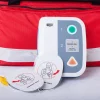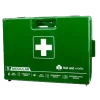
Recent Post
 Could You Recognise the Signs That Someone Needs a Defibrillator?
Could You Recognise the Signs That Someone Needs a Defibrillator?
September 12, 2023
Introduction
An Automated External Defibrillator, better known as an AED, is a literal lifesaver in situations of cardiac arrest. This handy device helps to restore a regular heart rhythm, often proving crucial to survival. But what role does an AED battery play in this life-saving process? The answer might be more critical than you think. In this piece, we’ll delve into the details of why a high-quality AED battery is so essential for survival in cardiac arrest situations.
Understanding Cardiac Arrest and its Implications
Cardiac arrest – these two words can send a chill down anyone’s spine. It’s a sudden, often unexpected event when the heart stops beating, resulting in a swift cessation of blood flow to the brain and other vital organs. In Australia alone, recent statistics show that approximately 33,000 people experience out-of-hospital cardiac arrest each year, and survival rates remain distressingly low.
Every second counts when a cardiac arrest strikes. The quick delivery of a defibrillation shock often means the difference between life and death.
The Role of AEDs in Cardiac Arrest Response
Now, let’s talk about the superhero in this story – the AED. This device, accessible in many public places across Australia, analyses the cardiac rhythm and delivers an electric shock to the heart if necessary. It’s straightforward enough for even a layperson to use. The catch? Time is of the essence, and this is where the AED battery enters the scene.
From local gyms to shopping centres, AEDs have saved countless lives. Their ease of use and availability make them an essential tool in the fight against sudden cardiac arrest.
The Importance of AED Battery Life
You might be thinking, “It’s just a battery, right?” Well, not exactly. A battery is the lifeline of an AED. Without a fully functioning, high-quality battery, an AED can’t do its job effectively.
The battery powers the AED, ensuring it can analyse the heart’s rhythm and deliver a potentially life-saving shock. If the battery is failing or of subpar quality, it could falter at this critical task. Studies have shown a direct correlation between battery quality and successful defibrillation.
Choosing High-Quality AED Batteries
Choosing an AED battery isn’t a decision to be taken lightly. Quality, reliability, and longevity should be top considerations. Remember, a cheaper option might seem attractive but think of the potential cost. A couple of hundred dollars saved now could mean a life lost later.
Australia is home to a range of brands offering top-notch AED batteries. But don’t just go by the brand name. Research their track record, read reviews, and always opt for quality over cost.
Maintenance and Regular Check-ups of AED Batteries
An AED battery isn’t a ‘fit and forget’ item. It demands regular check-ups and maintenance. Overlooking this can lead to battery failure, potentially compromising the AED’s functionality in an emergency.
So, how do you ensure your AED battery is in top shape? Regular check-ups, adhering to Australian guidelines, and promptly replacing batteries approaching their end of life are all part of effective AED maintenance.
Conclusion
In conclusion, a high-quality AED battery isn’t just a power source for a life-saving device. It’s a cornerstone of effective cardiac arrest response, contributing significantly to survival rates. Ensuring we opt for high-quality batteries, maintain them properly, and replace them when needed isn’t just about maintaining a device; it’s about safeguarding lives.
The saying ‘the power is in your hands’ has never been more accurate. Because with a well-maintained, high-quality AED battery, you could have the power to save a life.
Isn’t that worth investing in?






